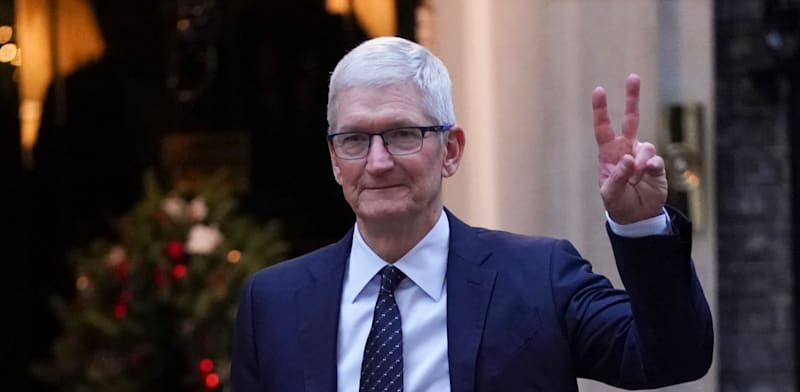A stock dark Six in Wall Street, after US President Donald Trump announced a series of new customs rates that could cause technology giant economic damage estimated at $ 8.5 billion over the coming year.
In one blow, Trump has made Apple’s business strategy to move away from China, announcing new 46% customs tariffs on Vietnam and 26% on India – exactly the countries that Apple has transferred much of its production in recent years.
● “The most expensive and masked tariffs the US has taken”: How did economics respond to Trump’s lids
● The Covers Program that arises the world: the country that is most damaged, and whether there is a purchase opportunity here
● Technology giants’ rescue rope: Will chips be excluded from the lids?
Apple began conveying to Vietnam following the Corona crisis in 2020 that caused the closure of factories in China, and to India as part of a strategy to avoid Trump’s previous tariffs on China-this is another in its first term in 2018.
Although the White House has stated that the tariffs come into force immediately, many trade experts believe that this is just a preliminary step designed to open a negotiation with these countries to reduce the tariffs they impose on American goods.
For Apple dual hit-The company is already dealing with 20%rates on products imported from China, and now Trump intends to upload this rate to 34%, bringing the effective customs of products from China to 54%.
Therefore, Trump’s new tariffs, which he calls “mutual rates”, put Apple to a hard dilemma. The iPhones, iPads and smart watches are three quarters of its annual revenue, estimated at $ 400 billion. Now that Trump has made it clear that he will not be exempted to specific products, Apple faces two problem options: to absorb customs costs and damage its profits – or raise products prices to consumers and thus risk a decrease in sales.
The profits will be damaged
According to Morgan Stanley, the tariffs on iPhones and other appliances imported from China will increase Apple’s annual costs of about $ 8.5 billion, without any relief from the Trump administration. The bank also estimates that this will reduce the company’s profits next year for $ 0.52 per share, or $ 7.85 billion in total-a 7% damage to the annual profits.
“Apple will take these new tariff numbers and put them in the models it has built and know within hours how big the problem is in front of it,” she told the New York Times, Anna-Qatarina Shaldzky, the founder of an instrumental company that worked in the past.
After Trump took office in the previous term, Apple Tim Cook CEO arrived at the White House and promised hundreds of billions of dollars in the US. In February this year, Apple exercised this promise and pledged to invest $ 500 billion in the US, although a significant part of the amount was already included in its existing expense plans.
During Trump’s previous presidency, Cook’s efforts to build a relationship with the president helped Apple to avoid rates on most of its products – the administration avoided imposing covers on iPhones and even removed tariffs from the company’s smart watch.
Also, in 2019, Trump toured Apple’s Texas factory that produces desktop computers. Cook stood alongside Trump when the president took credit on the factory, even though the factory had already produced computers from 2013.
Ironically, in the years since, Apple has not made the production of any major product to the United States, but focused on diversifying its supply chain beyond China. Starting in 2017, Apple has begun to set up assembly lines for iPhones in India, a five-year process for training workers and building infrastructure for producing the new models. From the 200 million iPhones sold every year.
At the same time, Apple has managed the production of Airpeods – the company’s headphones, iPads and laptops to Vietnam. Today, Vietnam factories make up more than 10% of the company’s leading 200 suppliers, with the main benefits being the country’s sacrifice to China, and India was selected for being the second largest smartphone market in the world.
A significant challenge
However, it is important to note that Apple struggled with US production. In Texas, for example, problems were discovered when some employees left the job after their shift but before their replacements came, which forced the company to close the assembly line.
Cook said at the time that the US does not have enough skilled production workers to compete in China. At the end of 2017, he said China is one of the only places where Apple can reliably find people capable of running the most advanced machines that produce its products.
Now, Trump’s new tariffs place a significant challenge to Apple. As of this time, almost all of its global production strategy is influenced by these tariffs, and it will have to choose as stated between the absorption of the additional costs and raising prices for consumers, and the experts have a contract that the economic implications are expected to be significant.
Please note: The Globes system strives for a diverse, matter -of -fact and respectful discourse according to the ethical code that appears in the trust report by which we act. Expression of violence, racism, incitement or any other inappropriate discourse is filtered in a way Automatically And they will not be published on the site.
